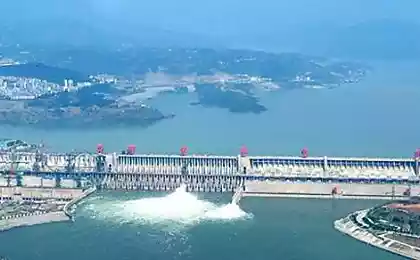795
Top 10 largest reservoirs in the world, created during construction of hydropower plants

Sea nutricap-10 largest reservoirs in the world, created during construction of hydropower plants.
1. Victoria (Uganda, Tanzania, Kenya. HPP "Owen falls")

Full volume: 205 km3
Area: 76 000 km2
Length: 320 km
Width: 275 km
Maximum depth: 83 m
Year completed: 1954
Opens the list of one of the largest lakes of the world (the second largest freshwater lake in the world after Top in North America), transformed by the will of man in the world's largest reservoir. It appeared after construction of the HPP in the village of Owen falls, flowing from lake Victoria the river Nile. The station was allowed to provide power supply nearly all of Uganda and parts of Kenya. In the early 2000s, a kilometer downstream from the "Owen falls" was put into operation another power plant is the "Kiir".
2. The Bratsk (Russia. The Bratsk hydroelectric power station)

Full volume: 169 km3
Size: 5470 km2
Length: 570 km
Width: 25 km
Maximum depth: 150 m
Year completed: 1967
The fate of the distant Bratsk stockaded town, once known as the place of exile for freethinkers and the reference point for the collection of tribute from the local tribes, abruptly changed in the mid 50-ies of XX century – the beginning of construction on the Angara Bratsk hydroelectric power station. The result was the largest in Russia and the second largest in the world the reservoir. On the energy basis of the Bratsk hydroelectric power station there was a huge industrial cluster.
3. Kariba (Zambia And Zimbabwe. HPP "Kabor")

Full volume: 160 km3
Area: 4450 km2
Length: 220 km
Width: 40 km
Max depth: 78 m
Year completed: 1963
In the South-Eastern part of Africa, on the border of Zambia and Zimbabwe, lies the third largest reservoir in the world – Kariba, created in the late 50-ies of the last century to meet the needs of the plant. The filling of this huge reservoir was preceded by at least a Grand preparation. Animals that lived along the banks of the Zambezi river, caught, loaded into boats and transported to a safe distance. For people, namely representatives of the peoples of Tonga, anciently inhabited the district of future flooding, has developed a special program of resettlement to cities in Zimbabwe and Zambia. This whole operation has received eloquent name "Noah". Hydro capacity of 1.2 GW is still working, almost fully covering the needs of Zambia and Zimbabwe's electricity. The region is actively developing the fishing and the warm waters of lake Kariba irrigate vast plantations of rice, maize, tobacco and sugar cane.
4. Nasser (Egypt, Sudan. Aswan)

Full volume: 157 km3
Area: 5120 km2
Length: 550 km
Width: 35 km
Maximum depth: 130 m
Year completed: 1970
The need to regulate the Nile floods the Egyptians realized even in ancient times, the first dam project to control the flow of the great river was compiled in the eleventh century. However, the full technical ability to do this came only nine centuries later. In the 1960-ies the first cataract of the Nile, near Aswan, Soviet specialists built the famous Aswan, not only provide Egypt with electricity, but failing once and for all solve the problem of flooding. The resulting lake Nasser (named after Egyptian President Gamal Abdel Nasser), or the Aswan reservoir has become one of the largest in the world.
5. Volta (Ghana. HPP "Akosombo")

Full volume: 147 km3
Area: 8500 km2
Length: 400 km
Maximum depth: 80 m
Year completed: 1967
Excluding lake Victoria, the Volta reservoir in Ghana – the largest artificial reservoir on the planet. He appeared in the mid 1960-ies the construction of HPP "Akosombo", designed to provide electricity for the aluminum plant in a suburb of the capital Accra. Today water volts irrigate 320 000 hectares of farmland in what was once the most arid region of the Gulf of Guinea. In addition, the construction of the reservoir helped to solve the problem of water supply for millions of local residents, to improve the transport system and to encourage the development of fisheries.
6. Krasnoyarsk (Russia. The Krasnoyarsk hydroelectric power station)

Full volume: 73,3 km3
Area: 2000 km2
Length: 388 km
Width: 15 km
Maximum depth: 105 m
Year completed: 1967
The second volume in Russia and the sixth in the world, the Krasnoyarsk reservoir stretches for nearly 400 km from Abakan in the Republic of Khakassia to Divnogorsk in the Krasnoyarsk region. Emerged in the late 1960-ies the construction of hydroelectric power station of the same name, today it is not only a stronghold of the Siberian energy system, but also performs an important transport function. The construction of the reservoir allowed to create a transport path from Minusinsk to the mouth of the Yenisei. And of course, the Krasnoyarsk sea, as the locals call it, is a favorite vacation spot of Krasnoyarsk citizens and guests of the city.
7. Zeya (Russia. The Zeya hydroelectric station)

The full volume of 68.4 km3
Area: 2420 km2
Length: 227 km
Width: 24 km
Max depth: 34 m
Year completed: 1974
Zeya reservoir, created on the left tributary of the Amur, Zeya, at the same hydroelectric power station, is located in one of the most beautiful and inhospitable places of our country. The average annual temperature difference is 80 °C. the Reservoir provides the plant and supplies water and fish 20 th city of see. Thanks to the dam and reservoir in 2007, was saved from severe floods of the valley of the Zeya and the capital of Amur region is Blagoveshchensk.
8. Ust-Ilim (Russia, Ust-Ilim hydroelectric station)

Full capacity: to 59.4 km3
Area: 1870 km2
Length: 302 km
Width: 12 km
Maximum depth: 100 m
Year completed: 1977
The Ust-Ilimsk reservoir is directly adjacent to the Bratsk and Irkutsk, forming the Angarsk cascade of hydroelectric power station – the largest in our country gidrotekhnicheskoe complex. Thanks to the reservoir provided by the energy of the Ust-Ilim timber processing plant – the second in the country in terms of production. The reservoir is actively used for water supply and navigation and is one of the leading fish stocks. Ust-Ilim hydroelectric station is considered to be one of the most economical in Russia. It is estimated that over the years she had covered the costs of their construction of 11 times.
9. Kuibyshev (Russia, Zhigulevsk HPP)

Full volume: 58 km3
Area: 6450 km2
Length: 500 km
Width: 40 km
Max depth: 41 m
Year completed: 1957
Kuibyshev reservoir, or as it is called, Zhigulevskoye sea – the third largest artificial reservoir in the world. It arose in the late 1950-ies by the construction of the dam Zhigulevskaya HPP in the middle reaches of the Volga. Located in the heart of one of the most industrialized regions of the Kuibyshev reservoir plays a leading role in its energy supply: Zhigulevskaya HPP produces more than 10 billion kWh of electricity per year. Water Zhigulevsky sea irrigate about 1 million hectares of farmland. In addition, the favorable climate and accessibility have transformed the coast in the area of tourism and recreational fishing.
10. Irkutsk (Russia. The Irkutsk hydroelectric power station)

Full scope: 31,5 km3
Area: 32 km2 970
Length: 636 km
Width: 80 km
Maximum depth is 1642 m
Year completed: 1959
The deepest reservoir in the world simply because main part of it is the deepest lake in the world – Baikal. The reservoir, created in the mid 1950-ies during the construction of the Irkutsk hydroelectric station on the Angara, allowed to eliminate the threat of catastrophic winter floods that have repeatedly led to significant flooding of Irkutsk. Largely depends on uninterrupted work of all of the Angarsk cascade of hydroelectric power stations.
published
P. S. And remember, only by changing their consumption — together we change the world! ©
For reference
- In total there are more than 30,000 reservoirs with a total volume of about 6000 km3
- In Russia, 1,200 reservoirs, their total volume – 900 km.
Source: www.5thelement.ru/water/more-vnutri.html
4 principles on which to build relationships
A fun and inspiring videos that promote energy efficiency and alternative energy























